
We are celebrating 15 years — and counting — of stories that are deeply researched and deeply felt, that build a historical record of what the city has been.
We are celebrating 15 years — and counting — of stories that are deeply researched and deeply felt, that build a historical record of what the city has been.
As an architect and writer, Susanne Schindler focuses on how design and policy affect the form, funding, and lived experience of housing. In two previous articles for Urban Omnibus (co-authored with Juliette Spertus), she has looked at historical examples where design and policy have converged to produce the singular developments of Co-op City and Twin Parks in the Bronx. Below, she takes us to Sugar Hill, a recently completed building that will house low-income residents, a children’s museum, and a daycare center. The building’s bold architecture and high costs have already sparked much discussion from architects, policymakers, and housing advocates. But Schindler’s in-depth analysis delves beyond the criticism. Her conversations with the architects and the developer, and her close reading of architectural details, construction methods, and financing strategies reveal how Sugar Hill embodies ingrained and limiting attitudes about the symbolic capital of architecture and the political and financial drivers of affordability. The building also, Schindler argues, might suggest new lessons for how our understanding of “architecture” and “housing” might be more meaningfully integrated in the future. –C.S.
Sugar Hill is a new residential building that makes a striking addition to the highest and most visible point of the neighborhood of the same name. The critically acclaimed London-, New York-, and Accra-based firm Adjaye Associates, led by architect David Adjaye, designed the building. Broadway Housing Communities (BHC), led by Ellen Baxter, a non-profit pioneer of supportive housing, developed it. It is BHC’s seventh development offering permanent housing for special-needs or low income populations, but its first ground-up construction. Located along 155th Street, an important east-west connection between Harlem and the Bronx across a tangle of iron bridges, the dark, almost gloomy 13-story building sits between 19th-century brownstones to the west, an industrial mix to the east, and the topographically undulating green expanses to the north, punctuated by the towers of the New York City Housing Authority’s (NYCHA) Polo Grounds public housing complex.
When I saw early renderings of the building — planned to accommodate 124 apartments for low-income as well as formerly homeless households, a 100-seat preschool, and a children’s art museum — I was immediately intrigued. By boldly offsetting two volumes and irregularly placing the windows, Adjaye’s design offers an in-your-face, unapologetic embrace of — and twist on — New York’s housing vernacular: the brick tower with repetitive punched windows. I was struck by the choice of concrete, not the most beloved of façade materials. And I was amused by complaints among peers of “too much architecture,” as one architect put it, insinuating that Adjaye had imposed his artistic ego instead of allowing the economic formulas of housing to generate the building’s design.
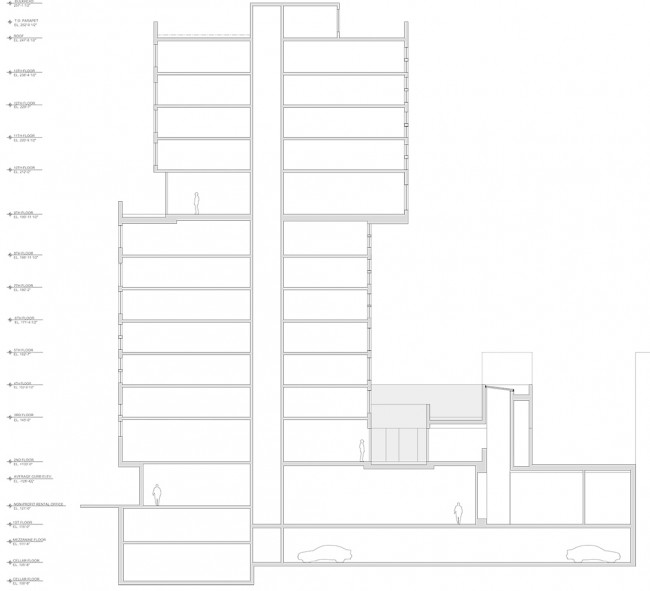
Cross section of Sugar Hill. From bottom to top: parking, museum, childcare center with exterior courtyard (shaded), and apartments. BHC offices, community room, and terrace are located at the ninth-floor setback. | Image courtesy of Adjaye Associates
A closer look reveals how intelligent organization fits five uses into a challenging site. The childcare center, the museum, and the housing each has a distinct point of access off a plaza along St. Nicholas Avenue. The childcare center — six classrooms given full-height glazing to the north and east and two open-air courtyards to the south — takes up most of this level. The museum, beginning with a narrow lobby fronting the plaza, expands into the ground below, daylit through skylights. And the housing, with a only narrow entrance leading straight into the depths of the building, expands up. A community room, BHC offices, and a terrace occupy the setback level, and the building is ultimately topped off by a rooftop farm. A commercial space is reserved for non-profit tenants along 155th Street. The commercial parking garage, on the building’s lowest level, is adjacent to the gas station on the corner of St. Nicholas Place.
The smart arrangement of different uses is only part of the story. What I find most interesting is how Sugar Hill might counter an attitude, so prevalent in the United States, that “housing” is oppositional to and incompatible with “architecture.” The idea that the two are distinct and irreconcilable is based on fallacies and misperceptions about the role of design and the calculus of cost and benefits. Sugar Hill presents an opportunity to complicate and move beyond this simplistic binary. Rather, it offers important insights into the constraints that shape housing development in New York today, especially housing intended for lower than market rents.
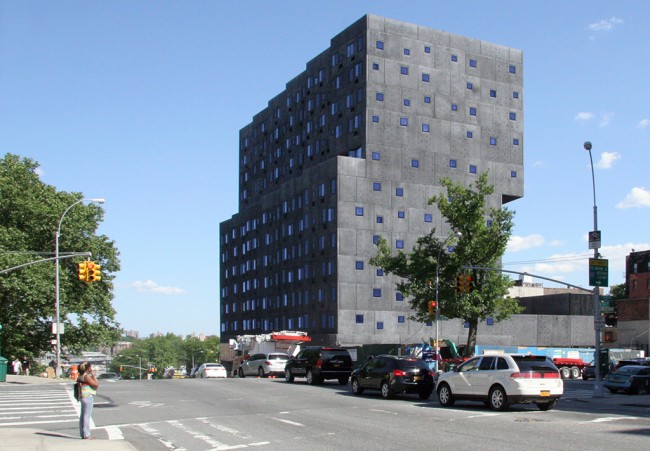
The realized building seen across the intersection of St. Nicholas Avenue and 155th Street, May 2014. | Photo courtesy of Adjaye Associates
The Cost of Architecture
Housing — whether modified by the adjectives public, social, subsidized, low-income, workforce, or affordable (or even in its so-called market-rate version) — is considered a socioeconomic product to be delivered at the least possible cost to the public sector, while generating maximum economic benefit to private developers.[1] Architecture, in contrast, is viewed as a cultural endeavor, concerned with museums, universities, or houses, whose economic fundamentals seem not to matter.[2] If related to multi-family housing, architecture seems legitimately available only to those who are paying “market-rate” for where they live, in “New York by Gehry” for instance.
But all housing is subsidized, whether through indirect public expenditures (property tax abatements) or through direct public investment (infrastructure of roads, water, electricity, parks). And “affordable” — the current term used to describe government-regulated, income- and price-restricted housing — is a highly malleable and imprecise term, often masking which income group is expected to benefit. I will instead refer to the housing at Sugar Hill as “below-market.”[3] This term is perhaps most useful to indicate that even in housing for those underserved by the market, the market-based promise of profit remains a key determinant.
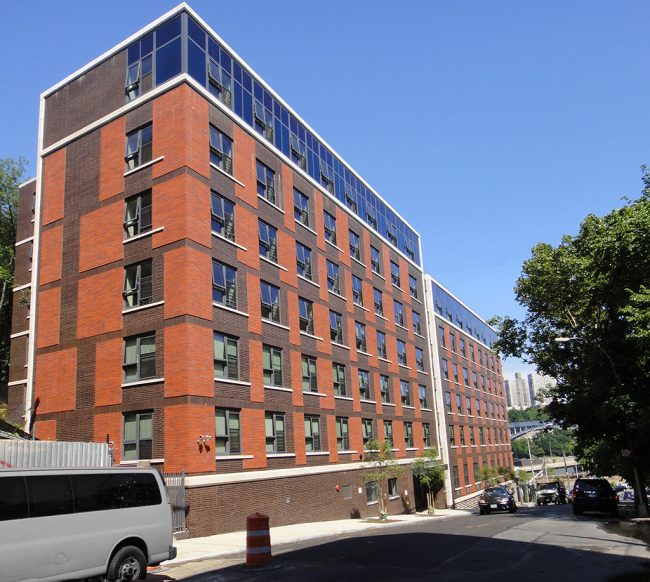
Highbridge Terrace, below-market housing in the Bronx, designed by SLCE Architects for Dunn Development Corp. and completed in 2012 | Photo by Hanna Browning, courtesy of SLCE Architects
One explanation for this perceived opposition between “architecture” and “housing” is that architecture is rarely considered an essential part of a long-term cost-benefit calculation of below-market housing. More often than not, architecture is seen as an add-on or luxury, expressed in the colors or materials of the façade. To counter this notion, we should be asking what architects’ rethinking a building’s program or spatial arrangement might enable. How can architects improve construction methods or optimize heating and cooling systems? And how can these fundamentals resist being quantified as short-term, upfront development costs and instead be categorized as long-term contributions to individuals and society? The corollary of the attitude that architecture is an add-on is an overemphasis of its role in the success or failure of below-market housing. See Pruitt-Igoe.[4]
The reviews of Sugar Hill published to date confirm the perception that the goals of architecture and those of housing are in conflict. A press conference in early June attracted an impressive cast of local, state, and federal politicians whose accolades of a “beautiful” and “replicable” building led to many articles arguing that the building was neither. Crain’s New York mocked the economics, focusing on the fact that the “city calls $500K-per-unit building ‘affordable,’” citing the city’s average per-unit development cost of below-market housing as between $350,000 and $400,000.[5] New York Magazine focused on aesthetics, calling the building an “arty fortress” (recalling an earlier comparison to a “prison”[6]), lamenting that the quality of the design apparent on the interior of the museum, childcare, and apartments hadn’t left its mark on the exterior.[7]
Sugar Hill seems to share the fate of the South Bronx’s Via Verde, a signature development project completed by Phipps Rose Grimshaw Dattner in 2012. Explicitly conceived as a project to advance design in below-market housing by providing a model that would be “affordable, sustainable, and replicable,” the project has since been deemed “unreplicable” in policy circles due to its above-average unit cost. Nice architecture, too costly. Sorry. But quality architecture can contribute more than just extra costs.
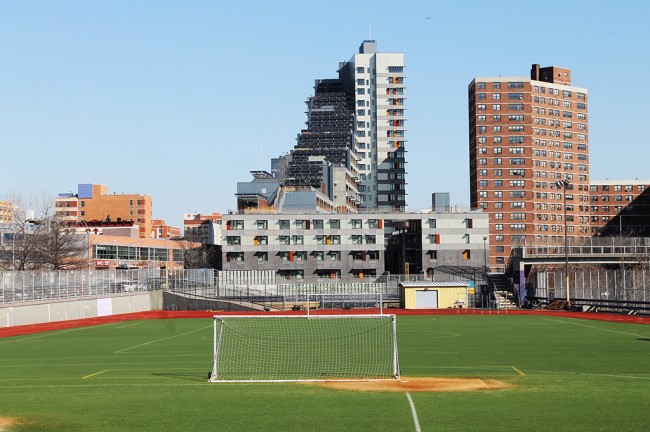
Via Verde | Photo by Jules Antonio
Design as Leverage
Since its founding in 1983, BHC’s model of housing that mixes special-needs population with low-income families, often in buildings managed by residents, has been celebrated. But the approach remains hard to finance because of a heavy reliance on private, for-profit funding sources. The incentives that bring these partners to the table are policies and programs that largely focus on narrowly defined goals. The units’ income- and price-restrictions generally expire after only 15 or 30 years, all the while generating 10+ percent return for the partners.[8] As Ellen Baxter puts it, “permanent affordability is not really accurate. It’s our intention, … but it is legally impossible to write into the documents because that would [aim to] control the market.”
Despite these systemic challenges, BHC has managed to create a building serving exclusively low and very-low income households.[9] That the organization welcomed, in Baxter’s words, “fresh perspectives” by an emerging architect to create an “icon” should be celebrated. And the result should be evaluated (if evaluation is even possible when the building has not yet been occupied) in the context of the financial and regulatory constraints BHC faced in developing the building.
So why did BHC choose Adjaye Associates — a firm inexperienced in multifamily housing and known instead for cool urban residences and colorful libraries in low-income London neighborhoods — to design its first ground-up project? And what does the resulting building contribute, architecturally, to how we deliver housing in the United States?
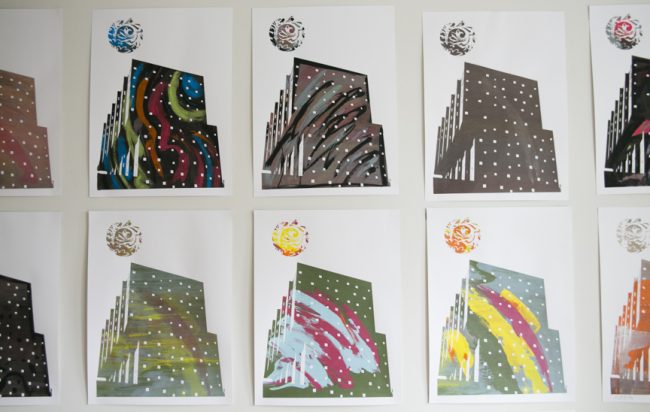
An installation in If You Build It, No Longer Empty’s site-specific, multi-floor art exhibition that took place in Sugar Hill prior to its opening. For more information about the exhibition, visit No Longer Empty’s website. | Photo by Whitney Browne, courtesy of No Longer Empty
Ghislaine Hermanuz, professor of architecture at City College and a member of the project’s architect selection committee, described the selection process to me. In 2008, BHC purchased a site close to the neighborhoods it has historically served and issued an RFQ to architects later that year. According to Hermanuz, the resulting list had “very few minority firms, which angered some in the selection committee.” The list mostly consisted of “traditional firms: what they would have done would not have been bad, but not particularly interesting either.” Among them were Robert A.M. Stern, Ennead, and SLCE. Adjaye was invited on the basis of his past projects but certainly also for his Ghanaian origins. After interviews with seven finalists, the selection committee unanimously recommended Adjaye. Given the site’s difficult 30-foot grade change and its location in a historic district, “David’s evident eagerness to honor the history, that he appreciated that it would be visible from a distance,” as Baxter put it, made the difference.
The selection of the young, elegant, and eloquent architect[10] helped both the community process and fundraising efforts. The City’s Department of Housing Preservation and Development (HPD) would approve the building’s color only with the community’s OK. Adjaye explains the Community Board’s unanimous approval as an outcome of his firm’s commitment to showing residents the “complexity of [their] place”: Sugar Hill is not just 19th-century brownstones or post-war highrises; it’s a heterogeneous mix. His appeal argued that the “raw materiality” and the “textural density [of the façade] becomes an emotional signature over time.” He rejects the notion that a lay audience cannot appreciate his design approach. “It is a cliché that poor housing has to be ‘pretty,’” he says, positing any superficial niceness as condescending and pointing to the numerous all-black, multi-textured private residences he has worked on in London, Brooklyn, and New York’s Upper East Side. He rightly asks: “Why is it that this is ‘cool’ for rich people but ‘tough’ for poor people?”
Having Adjaye on board also helped BHC pull together an impressive $14.5 million in philanthropic funding. Once Adjaye was selected to design the Smithsonian’s Museum of African American History and Culture in Washington in 2009, Adjaye says that BHC was able to “leverage me.” If his cultural capital may seem obvious today, Hermanuz underscores that Adjaye was “an obscure entity” to many at the time he was chosen, and that “BHC took risks in the architect selection.”
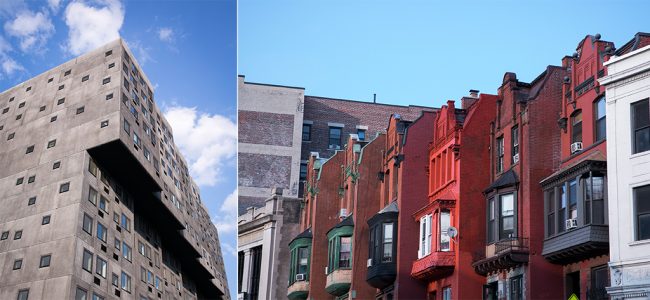
Sugar Hill and row houses in the surrounding neighborhood that its staggered façade references | Photos by Whitney Browne, courtesy of No Longer Empty
Realizing the project also required experience, BHC retained SLCE as the architect of record. The firm has a long track record of housing and previously had been working with BHC on zoning studies for the Harlem site. Once the two firms “were married,” as Saky Yakas, partner in charge at SLCE, put it, SLCE was in charge of zoning, massing, unit layout, and the production of contract documents and details, while Adjaye Associates was responsible for designing the museum, the daycare center, and the corridors in the housing above. Adjaye Associates, with Marc McQuade as project architect, contributed the key design ideas: to cantilever the upper volume in response to the required zoning setback at a 76-foot height along the 155th Street street wall; to use precast concrete panels embossed with rose patterns, inspired by the plant motifs found on terracotta panels in the neighborhood’s older building stock; and to organize the building, again referencing the historic building stock, into six staggered bays.
Architecturally, Sugar Hill charts new territory in terms of massing, use of material, and program organization. It is not particularly innovative in terms of what kind of apartments were built, however. The design clearly prioritized the exterior and non-residential parts; in Yakas’s words, “the museum and daycare are fantastic, but the housing is what it is.” Sugar Hill is a standard, double-loaded corridor building that offers only the standard range of studio to three-bedroom apartments. Why?
The answer might be found in short-term cost calculations and established economic formulas. Double-loaded corridor buildings are the ubiquitous spatial organizational strategy in multi-family, elevator-accessed housing across the United States. This strategy maximizes the rentable or salable square feet (the net) by minimizing those square feet that need to be shared by all (the gross). But apartments in such buildings have only a single orientation, meaning that cross-ventilation of units is impossible, and the corridor generally remains without daylight. At Sugar Hill, the corridor certainly received special treatment, its graphite-colored walls and floor and vertical lighting boxes giving it the air of a Chelsea gallery. It widens slightly toward the center and tapers toward the ends. Even though the basic unit configuration limits the potential for variation among the units, the patchwork panorama of unexpected views, framed by windows of different sizes located at different heights (“children’s window,” “adults’ window”) makes each apartment feel unique. Nonetheless, I wonder if it would have been possible to challenge the “net-to-gross” inevitability of the double-loaded corridor. Perhaps rethinking the size, shape, and configuration of residential units could have created an altogether different solution.
The limits of adherence to economic formulas are particularly evident in the type of units available. There are twelve on a typical floor: five studios, two one-bedrooms, four two-bedrooms, and only one three-bedroom. Multigenerational or multi-family households, let alone a live-work set up, are all but excluded.[11]
Baxter explains that the building’s “51 studios were strictly a financial concession … to achieve the 124-unit goal.” She says that BHC “didn’t even consider asking HPD for four-bedrooms,” given the agency’s track record: the last time four- and five-bedrooms were built in multi-family below-market housing was in the 1970s. HPD funds housing on a per-unit basis, independent of the unit size: the studios thus “cross-subsidize” the larger units and developers are discouraged, or have no incentive, to build larger apartments. When I asked him about the unit sizes, Adjaye admits that he did not question the program given to him by BHC and acknowledges that perhaps he should have.
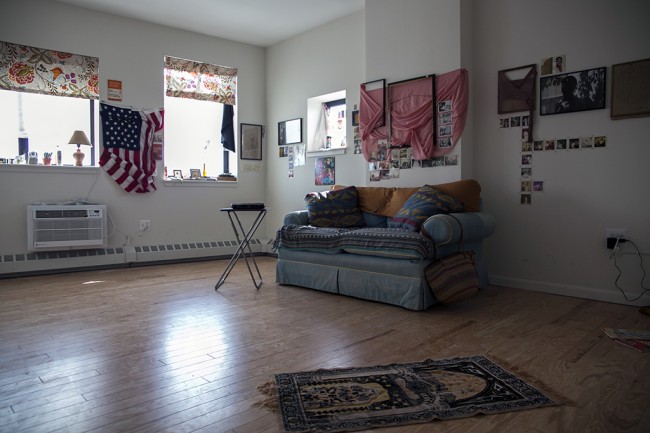
An apartment in Sugar Hill, with an installation as part of No Longer Empty’s If You Build It exhibition | Photo by Whitney Browne, courtesy of No Longer Empty
The financial and economic logic driving the design of the building’s interior seems at odds with the strong vision of its exterior. The six bays that structure the northern and southern façades do not align with the interior divisions of units and rooms, creating remainder spaces, sometimes less than one-foot wide by one-foot deep. Optimistically, a small child will withdraw here with a pillow and book. Realistically, they are awkward, especially given a wall that is thicker than the window is wide. Adjaye describes these “chicanes” as “very intentional,” “cracks” that characterize all of his projects which depart from a functionalist approach to housing in which each use must be clearly defined and expressed architecturally. While these interferences might work on the large-scale façade of the Smithsonian, I found them often irritating here.
The choice to use prefabricated concrete panels, however, deserve kudos. The quality and method of construction, reintroducing a technique that hasn’t been widely used since the 1970s, should serve as a wake-up call to move beyond standard block-and-plank construction.[12] In addition to the differently sized windows, the floor-height concrete panels also accommodate openings for the wall-through A/C units. The irregular composition works, and their grilles are positioned flush with the concrete, ensuring Adjaye’s desired “monolithic” appearance of the building exterior. This was, according to the architect, a huge struggle to achieve since it would have been less expensive to have the individual A/C units project beyond the exterior, as they do in older buildings. Because they project on the interior, sometimes just barely below a window, they make the otherwise intriguing window placements somewhat of a mess. I wonder if the cost of the concrete frame, necessary for the cantilever, prevented the choice of an integrated, more energy-efficient heating/cooling system? Whatever the priorities were, the building nonetheless aims to achieve LEED Silver certification.
When I asked him to compare construction in the US and the UK, Adjaye reveals not only his own design focus, but broader challenges: “The American gift to architects is a fantastic as-of-right. You don’t have to fight for the bulk. What you’re fighting for is the details. Construction is tough: everything is about being tried and tested and generic. If you want something else, you have to do a lot of work to show that it works.” Hiring an emerging architect achieved what BHC sought: an iconic building in terms of massing and new perspectives in terms of construction. However, in terms of the actual housing, ingrained economic logic seems to have prevented everyone involved from moving beyond established models.
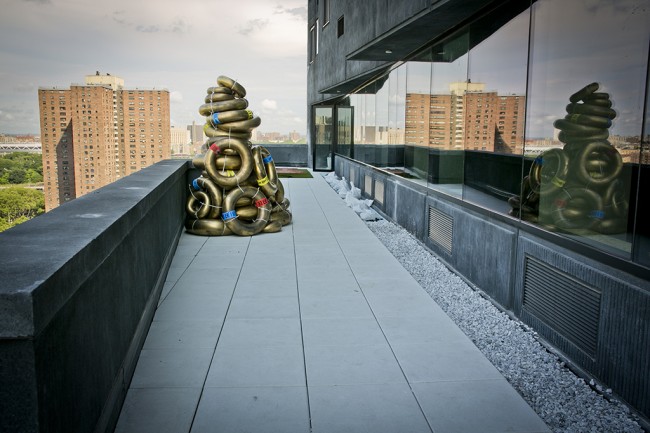
Sugar Hill’s community terrace, with an If You Build It installation and NYCHA’s Polo Grounds Towers in the background | Photo by Whitney Browne, courtesy of No Longer Empty
The Case for Alternate Cost-Benefit Analyses
But what about the cost? In explaining significant overruns[13], Ellen Baxter points to the project’s long delays in permitting and the need to accommodate infrastructure upgrades for the entire neighborhood. Due to its location in a historic district, both State and City agencies had to approve it, which took a year and a half, raising the holding costs. A new water main was installed due to the building’s sensitive location atop the Croton Aqueduct, and a required, neighborhood-wide Con Edison service upgrade brought four vaults and new transformers.
HPD would not comment on what the building’s financing strategy means for its replicability. I did, however, have a long conversation on this question with William Traylor, President of the Richman Group, a firm that assisted BHC in assembling the financing for Sugar Hill. Traylor stresses that the project brought together, in an unprecedented way, funding from a broad spectrum of public, private, and philanthropic sources and should therefore serve as model moving forward, not only for housing, but for housing integrated with other services.
The main sources of funding were two federal programs: the Low-Income Housing Tax Credit (LIHTC) and the New Markets Tax Credit (NMTC). LIHTC, the main permanent federal source of capital for below-market housing administered by the IRS, paid for the residential parts; while NMTC, a program set up to stimulate investment in underserved neighborhoods, financed the garage, office space, daycare, and museum. Both were administered by Capital One Bank, which also provided the construction loan. Traylor says that this is the first time these two programs were combined in a single project; Baxter points out that this is precisely what makes Sugar Hill replicable nationwide, since these are the two main sources federal sources of equity for housing and community development today.
In addition to these federal programs, Sugar Hill received funding from City and State agencies, some through dedicated programs for brownfield clean-up or homeless services. HPD and its finance arm, the Housing Development Corporation (HDC), provided $4.5 million in loans. According to Traylor, this amount is not exceptional; what is new is that the funds were applied to a non-residential program, the daycare center. Finally, Sugar Hill raises the bar in terms of philanthropic support. The $14.5 million total included a $10 million half grant, half loan by the Sirus Fund to purchase the site, two $2 million foundation grants, and a $350,000 ArtPlace Foundation for “creative placemaking.”
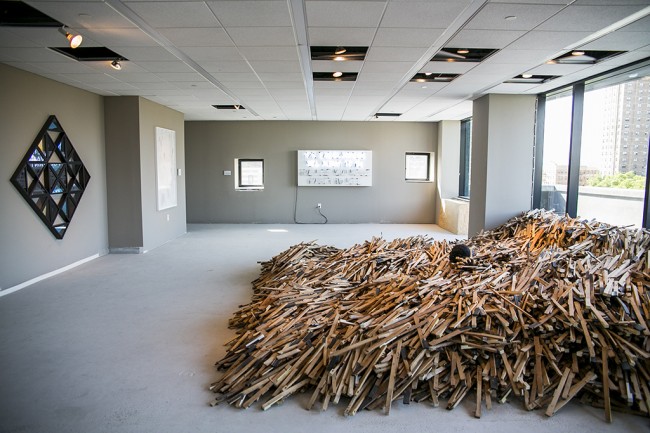
The community room at Sugar Hill (and terrace to the right) with If You Build It installations | Photo by Whitney Browne, courtesy of No Longer Empty
Based on the variety of funding sources, and what the building contributes to the neighborhood, Traylor finds fault with the media’s focus on per-housing-unit average costs, which he says wrongly factors in the high cost of the land as well as the project’s non-residential and infrastructural elements into the per-unit residential cost. He claims that the per-unit cost is, in fact, close to the Manhattan average: around $435,000/unit. But he is more interested in advancing a different cost and benefit analysis.
On a planning level, he sees Sugar Hill as a model for departing from the City’s housing-focused urban development approach. He envisions various City agencies — education, social services, parks, culture, city planning, transportation, housing — working collaboratively, both to “get all things in one package,” but also to tap into the agencies’ existing capital budgets to benefit projects not strictly within their purview. Traylor contrasts this approach to the mixed-use planning established by the Department of City Planning, which focuses primarily on zoning overlays.
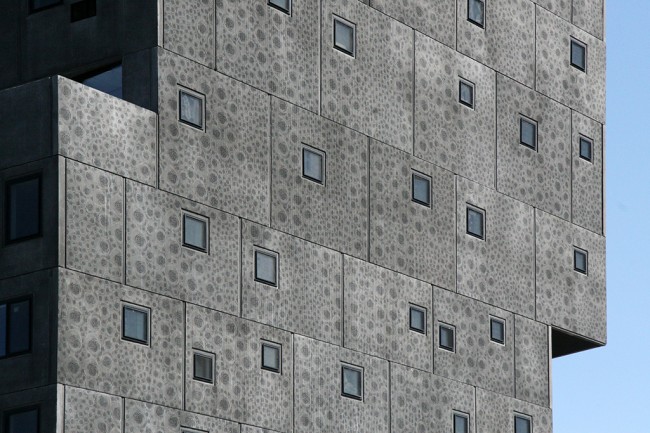
Because the side facades of Sugar Hill sit on property lines, the allowable size of window openings were limited by code, resulting in this scattered arrangement of smaller windows. | Photo courtesy of Adjaye Associates
On a funding level, Traylor suggests that we consider “what Sugar Hill leveraged for the city.” Pointing to the daycare center, particularly relevant in light of Mayor de Blasio’s universal preschool initiative, he suggests Sugar Hill as a model of how the City “can get things for free.” He argues that the private sector could more proactively invest in below-market housing, but concedes that the level of philanthropic contribution at Sugar Hill is not replicable. He would like the City to get out of directly constructing public amenities like schools to let the private sector do so “more efficiently;” the City would pay for them in long-term leasing agreements.
I find Traylor’s framing of Sugar Hill as an example of a different kind of collaborative, cross-agency approach to urban development convincing. It reminds me of the weekly roundtable of agencies that made possible the non-standard aspects of Via Verde, like the open kitchen or its innovations in the realm of unit types: two-story floor-through apartments, single-story apartments with exterior walk-up stairs, high-rise units with daylit corridors and stairs, as well as ground-level live-work units. Traylor’s focus on one amenity leveraging another also points toward a quantitative model that goes beyond unit counts and per-unit averages in housing, focusing instead on a project’s contribution to its residents’ and neighbors’ economic development and wellbeing, and, ultimately, the reduction of other costs. These kinds of evaluations can be made only over time; they cannot be made in terms of the up-front construction cost.
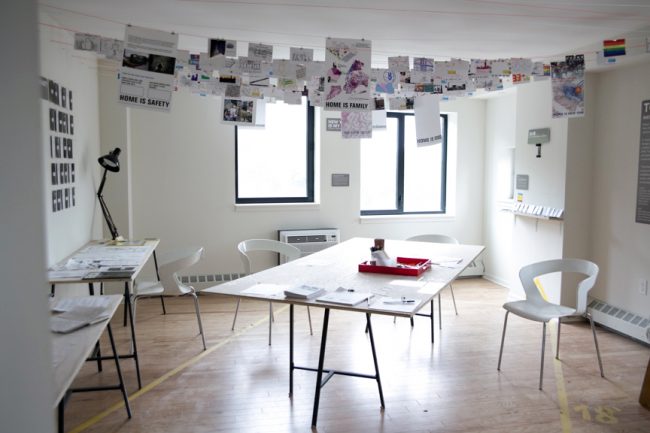
Interior of apartment used for the Institute for Public Architecture’s exhibit as part of If You Build It | Photo by Whitney Browne, courtesy of No Longer Empty
I am not convinced, however, by Traylor’s argument that the City should rely more strongly on the private sector to build housing, schools, or cultural facilities. These amenities, if they are intended to serve a broad population, do not generate profit — if they did the private sector would already be building them. Such projects require the long-term commitment of either an agency accountable to the public or a non-profit like BHC that will own and manage the building for years. Better design and higher quality construction are more likely to be an essential part of the consideration if the developer will also operate the building in the long term. Nothing is ever “for free”: Traylor’s model simply veils hard-to-argue-for direct public investment behind politically palatable tax credits, which go unnoticed in annual budget cycles. And yet the model assumes that not only the risk, but also the revenue generated for the private sector, is guaranteed by the public sector and, in the case of Sugar Hill, the non-profit sponsor.
In press materials and conversations, Ellen Baxter is frequently described as “visionary.” So is David Adjaye. A person familiar with the project has also called them “authoritarian.” I see both terms as compliments. If there hadn’t been two strong visions, both social and architectural, Sugar Hill’s integrated approach to housing, education, and culture, and its resolution in an iconic building, would never have been realized. The question remains why the architectural capital was spent primarily to create an iconic building instead of challenging some of the conventions governing apartment configurations and sizes.
We cannot rely on visionaries and authoritarians to generate more, and better, housing. They might deliver, with enormous risk and perseverance, through personal connections and their willingness to invest their own equity or to defer their developers’ fee, as BHC has done. But visionaries and authoritarians are few and far between. Rather, we need to formalize ways of rethinking and requantifying net-to-gross, studio-to-three-bedrooms, block-and-plank formulas. We need to broaden and fund the architect selection processes, ideally into open competitions, so that developers, agencies, and funders can tap into and commit to architects’ exploring, early on, the mutual implications of cost and design. And then we need to figure out ways that public, private, and philanthropic investment into below-market housing, made directly or indirectly, allows the housing to operate on a non-profit basis in perpetuity. And hopefully that long-term vision will contribute to making housing as architecture, or architecture as housing, more palatable and replicable.
NOTES:
[1] Starting in the late 1960s, the private sector came to be seen as an essential way to make low- and moderate-income housing production more efficient. Today, it is considered the essential provider, with direct government involvement, for instance as a client, virtually impossible. For a recent analysis of the very early origins of public-private models in the US see: Von Hoffman, Alexander. “Calling Upon the Genius of Private Enterprise: The Housing and Urban Development Act of 1968 and the Liberal Turn to Public-Private Partnerships,” Studies in American Political Development, 27 (October 2013): 165–194.
[2] For a more detailed reflection on the cultural and economic implications of “house” and “housing,” see the recent research at Columbia University’s Buell Center, directed by Reinhold Martin, Jacob Moore, and the author, in particular the exhibition House Housing: An Untimely History of Architecture and Real Estate in Nineteen Episodes, first presented as an exhibition in Venice in June 2014. www.house-housing.com
[3] In this article, I will use the term “below-market housing,” used by Nicholas Bloom and Matthew Lasner for their upcoming book Affordable Housing in New York City: Triumph, Challenge, and Opportunity, to be published in 2015.
[4] The seminal text in this respect is Catherine Bristol’s “The Pruitt-Igoe Myth,” Journal of Architectural Education, 44:3 (May 1991): 163–170. which analyzes how the design of the St. Louis highrises came to be seen as the key reason for the social decline of its residents, ultimately justifying its destruction.
[5] Joe Anuta, “City calls $500K-per-unit Harlem housing ‘affordable’,” Crain’s New York Business, June 10, 2014.
[6] Jeff Mays, “Sugar Hill Building Designed by Star Architect Sparks Controversy,” DNAinfo, December 3, 2013.
[7] Justin Davidson, “In Harlem, the Sugar Hill Complex Reimagines Affordable Housing As an Arty Fortress,” New York Magazine, June 9, 2014.
[8] The Low-Income Housing Tax Credit program, introduced in 1983 and made permanent in 1996, is the most important source of equity for low-income housing in the US today. It allows corporations a reduction of their tax liability if they “invest” in low-income housing. For every dollar invested, a dollar of their taxes is reduced. Because these credits are sold on a market, generally at less than a full dollar, this can lead to a generous return. For instance, if one dollar worth of credit is sold for 90 cents, the investor has a 10 percent return. For a succinct description of the LIHTC, see: the overview created by Novogradac, a leading accounting business.
[9] 70 percent of the apartments are targeted to extremely low-income (30 percent AMI, or below $25,750 for a family of four) and very low-income households (50 percent AMI, or below $42,950 for a family of four), with the remaining 30 percent rented to households below 80 percent AMI ($68,700 for a family of four). 25 of the 124 apartments are reserved for homeless families; of the remainder, 50 percent are reserved for residents of Community District 9. Residents were chosen by lottery and will not pay more than 30 percent of their gross income in rent.
[10] There have been an impressive number of articles in the past years focused on Adjaye’s persona, including those in the New Yorker, the Wall Street Journal, and most recently a telling portrait relating Adjaye’s rhetoric and his buildings in The Guardian.
[11] In my conversation with Baxter, she emphasized that she has always advocated a broad integration of special-needs individuals with low-income families, and that many in Washington Heights and West Harlem are not homeless in the sense of being “on the street” or “in the shelter system,” but are doubling up. I pointed to the fact that supportive housing became politically acceptable in the mid-1980s in large part due to a cost argument. Advocates showed that the cost of permanent housing integrated with medical and social services was lower than having homeless individuals cycle from the street through shelters, emergency rooms, and the justice system, to only end up back on the street. She strongly cautions against the current trend of medicalizing supportive housing, however, which she says is aimed at a very narrow cost-efficiency argument and concentrates, and segregates, individuals with the most intensive needs, rather than pursuing a more integrated approach serving a broader population.
[12] In block-and-plank construction, the masonry façades as well as an internal wall carry pre-stressed concrete floor planks. This method is particularly suited to mid-rise, double-loaded corridor buildings, since one of the corridor walls can be load-bearing.
[13] A Wall Street Journal article in 2010 cited the development cost to be $73 million; the HPD press release at the 2012 groundbreaking stated $80 million; BHC’s press release at the 2014 press conference lists $89 million.
The views expressed here are those of the authors only and do not reflect the position of The Architectural League of New York.
Comments